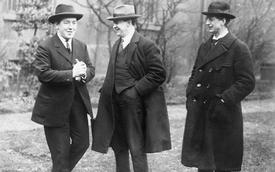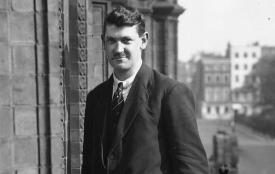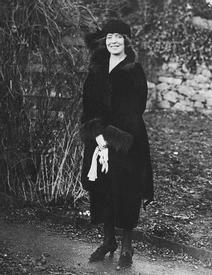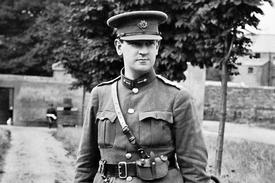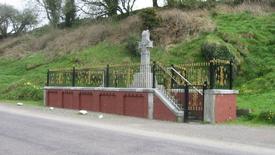Early on the morning of 22nd August 1922, a tall, striking man walked into a pub near the small town of Beal na mBlath in County Cork, Ireland. He was not there for an early drinking session. Dressed in the green uniform of the army of the newly formed Irish Free State, he and his associates asked the landlord for directions towards Skibbereen, in the southern part of the county. The landlord, who had a rifle resting on the side of the bar, gave the men the correct directions but enquired as to whether they would be travelling back through the area anytime soon. Upon finding out they were, he saw the party off down the road and immediately flew into action, rushing to gather his friends before the army men returned. A deadly ambush had been set.
The tall, striking man who walked into the pub that morning was 31-year-old Michael Collins, a Cork native who had shot to prominence as one of the main faces of the Irish republican movement. Having spent much of the previous few years leading a squad of assassins who targeted British intelligence officers in Ireland, he was now locked in a deadly struggle with his former republican comrades who were furious with his signing of a treaty in London that gave the southern part of Ireland ‘dominion’ status within the British Empire and kept six northern counties in Ulster as part of the United Kingdom. Only full independence for a united Ireland was acceptable for some republican hardliners who had now gone to war with Collins and his supporters. Unfortunately for Collins, one such anti-treaty fighter just happened to be the landlord from whom he had asked directions that fateful morning. As he climbed back into his car and set off from Beal na mBlath, he could not have known that he was destined to die on that very road in a matter of hours.
Making of a revolutionary
Michael Collins was born on 16th October 1890 in Clonakilty, County Cork, the youngest of eight children born to Michael Sr and Mary O’Brien. His family were not wealthy but could afford to live comfortably as farmers. They were not a particularly political family, but Michael’s attendance at a local school, where he was taken under the wing of a fiercely nationalist teacher, instilled in him a devotion to Irish nationalism and republicanism. This reflected one side of Collins’ character – serious and unsmiling – but he also possessed another side to his personality, one that enjoyed life, laughed a lot and was committed to sports, particularly hurling. An acquaintance of his would later note that Collins could switch from one mood to another in the blink of an eye, lecturing his friends about his causes one minute before bursting into laughter the next.
After leaving school, Collins qualified as a British civil servant and in 1906 he moved to live with his sister, Hannie, in west London. He took a job as a clerk for the Post Office, while undertaking further studies in accountancy. In many ways he lived the life of a typical British civil servant, making friends and socialising with his English colleagues and working in the beating heart of the British Empire, but he still harboured an intense passion for Irish nationalism. He joined a local Gaelic Athletic Association (GAA) club in west London and at the age of 18 joined the Irish Republican Brotherhood (IRB), a semi-underground organisation agitating for rebelling against, or at the very least putting political pressure on, the Liberal government in London who had promised a home rule bill for Ireland but kept delaying it.
The Easter Rising
The first world war put any plans for an Irish home rule bill firmly into the back of the government’s mind, and by 1916 a group of Irish republicans had had enough. They organised an armed uprising in Dublin, set for Easter Monday in 1916, and Michael Collins was involved in procuring weapons and intelligence for the venture. Unfortunately for the rebels, the rising went wrong almost from the start, with a mixture of poor communication and less enthusiasm than they had anticipated meaning that nowhere near as many supporters as they had hoped for showed up for the big event. Still, they went ahead and Collins was at the main venue of the rising, the General Post Office in Dublin, fighting in the six-day struggle with British soldiers who were sent to crush the rebellion. Crush it they did, and by the end of the week Michael Collins was languishing in a Dublin prison with his fellow rebels.
When the leaders of the rebellion were brutally executed soon after, Michael Collins could have been forgiven for fearing for his life. However, he was not executed and was released from prison in December 1916. The Ireland he walked out into was a different one to the one that had existed before the executions. While there had been general bemusement and little sympathy for the revolutionaries at the time of the rising, the executions had turned the tide of Irish public opinion. Collins was now stepping into an environment where republican sentiment was stronger than it had been for centuries, and where the executions of the movement’s key leaders had left a vacuum that needed filing. Michael Collins was ready to leap at his chance.
The execution of Irish revolutionary leaders in 1916 left a vacuum for figures like Collins (central) and Eamon de Valera (right) to fill. The two would later become mortal rivals (Irish Central)
Sinn Fein and War with Britain
Collins and his comrades were keen to exploit the momentum the rising had given them, but they could not escape the fact that the main focus on most people’s minds was still the war that was raging on the European mainland. Indeed, because of what happened after the war it is sometimes forgotten that around 200,000 Irishmen fought for Britain in the first world war, of whom around 35,000 died. In this context, where hundreds of thousands of Irish families had relatives on the western front and where there was some shortage of available fighting men, it was difficult for Irish republicans to generate the support they needed for another uprising, even if Irish public opinion had turned in their favour. However, Collins was given a gift in 1918 when the British government tried to impose conscription in Ireland, allowing him to present them as tyrannical and indifferent to Irish lives. He also used his time in the years 1916-18 to assemble an impressive spy network that would later serve him spectacularly well in the approaching war with Britain.
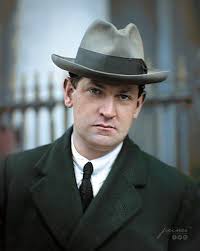
Michael Collins was elected as the MP for South Cork in 1918, but did not take his seat in Westminster (reddit)
When the war concluded in November 1918, Irish republicans were ready to seize their opportunity. A general election was held the following month and Collins stood as a candidate for Sinn Fein, the political party that was formed in 1905 with the sole aim of achieving Irish independence. Collins swept to victory in the South Cork constituency as part of a Sinn Fein landslide that saw them win 73 out of the 105 parliamentary seats in Ireland. However, the party decided not to take their seats in the Westminster parliament, so as to not legitimise Britain’s rule in Ireland. Instead, in January 1919 they proclaimed their own parliament, or Dail to use the Gaelic term, in Dublin. They declared independence from Britain, which the government in London took as a declaration of war.
The war would not be fought in the same way as the one that had just ended in Europe. Instead of trenches and massive offences, this would be a guerrilla war where both sides would sweep in and out of quick ambushes, causing maximum devastation with minimal risk to themselves. It was the kind of war in which Michael Collins, with his large spy network, excelled. After organising a loan for the fledgling Irish government in his initial role as Minister for Finance, he was made the Director of Intelligence for the IRA later in 1919 and turned his attention to organising brutal raids on British soldiers in Ireland. In response, the British government sent guerrilla fighters and spies of their own, including the notorious ‘Black and Tans’ and the ‘Cairo gang’. In this war of cunning and cruelty both sides were guilty of unspeakable atrocities, and Michael Collins was heavily involved. The man was certainly no angel, but like so many figures in history he would have argued that it was his people who were the oppressed and that his ends – namely, the expulsion of British influence in Ireland – justified his means.
Perhaps the most infamous of Collins’ attacks came on Sunday, 21st November 1920. Having assembled a squad of assassins and a list of British intelligence officers living in Dublin, Michael Collins gave the order for a horrific morning of violence. As the city rose that chilly Sunday morning, 12 British officers and two bystanders were murdered by IRA assassins – some in their pyjamas, some in front of their wives. In retaliation, British soldiers were sent to a Gaelic football match between Tipperary and Dublin at the city’s Croke Park stadium, where several of the assassins were suspected to be in attendance. The soldiers opened fire on the crowd, killing 14 people including Tipperary player Michael Hogan. In the evening, two suspected IRA members were shot in the street by British soldiers. In all, 30 people were killed on the day that would become known as ‘bloody Sunday,’ just over fifty years before another bloody Sunday in Derry. The vengeful reaction of British soldiers at Croke Park that day probably saved Michael Collins from a PR disaster – instead of having to account for unarmed British officers being shot in front of their wives, he could point to the massacre of the innocent spectators as yet more evidence of British atrocities in Ireland. He could have also pointed out (probably with some justification) that the men whose murders he had ordered were intent on killing him. This was war after all, and he would certainly not have apologised for striking first before he could be targeted. In any case, by the end of 1920 he was the most wanted man in Ireland, with the British government offering astronomical sums of money for his capture.
Celebrity in London
The British government was desperate to hold on to its power in Ireland but was coming under increasing pressure from parliament and the media to reach a truce with the republicans. So it was that in July 1921 the British Prime Minister, David Lloyd George, offered to host talks in London with a view to forging an agreement. Michael Collins was reluctant to go to London, knowing that the negotiations would be difficult and that as such a high profile figure he would be made a scapegoat if he returned with less than what was being demanded. However, he was ordered to go by Eamon de Valera, the President of the Dail and the only figure in the movement more powerful than Collins. De Valera had demanded that he be made President but adamantly refused to join the negotiating team in London, insisting that Collins attend instead. De Valera’s game was not well disguised: if Collins could go and achieve full independence for a united Ireland, then great. If he came back with anything less, then he could be got rid of. Collins was reluctant and the republican cabinet was split, but de Valera’s insistence won the day.
When Collins arrived in London in the autumn of 1921, he probably was not expecting the welcome he got. Far from being reviled as the man who had ordered the deaths of hundreds of British soldiers, he was splashed across the papers as some sort of celebrity by the British press, who were clearly charmed by the tall, mysterious figure who had arrived in their capital. According to Andrew O’Connor of the Irish Times, it was even rumoured that some high-society women were intent on seducing him, despite the fact that he had recently got engaged to his sweetheart, Kitty Kiernan. Staying in plush lodgings in Chelsea during the negotiations, he wrote to Kitty every day but enjoyed the favourable press coverage and female attention he received, even attending a few parties during his free time.
Collins was by now engaged to Kitty Kiernan. They would never get the opportunity to marry (wikipedia)
However, he was here for the serious business of negotiating a settlement with the British government, and he was finding the wily Lloyd George a tough nut to crack. The British government were willing to allow the southern, predominantly Catholic, counties of Ireland to become a ‘free state’ within the British Empire, but were coming under too much pressure from the six, predominantly Protestant, counties in the north and their loud supporters in parliament to allow for the whole of Ireland to leave the United Kingdom. After months of intense negotiations, the British government made clear that this would be their final offer, and they were willing to resume hostilities if it was rejected. Reluctantly, Collins and his team signed the treaty in December 1921. 26 counties in Ireland would become the ‘Irish Free State’ and be ruled by a government in Dublin, but the state would remain part of the British Empire and the six northern counties would remain part of the United Kingdom. Collins believed it was a step in the right direction that could be improved upon in the future, but he knew that de Valera was waiting to twist the political knife when he returned home. The night he signed the treaty, he wrote a prophetic line in his diary: ‘Today I signed my death warrant.’
The Irish Civil War
The treaty was put to a vote in the Dail and passed by one vote. The Irish Free State was established, but the republican movement was irrevocably split between those who supported the treaty and those who rejected it. Collins became both Chairman and Minister of Finance in the new government, after de Valera resigned his position as President of the Dail. In April 1922, anti-treaty forces occupied four courts in Dublin, presenting a direct challenge to the authority of the Free State. Collins desperately tried to avoid a conflict, preferring to keep his head down and try and concentrate on other government business, but his hand would be forced by events out of his control. On 22nd June 1922, a British army general was assassinated by the IRA outside his front door in London, prompting horror and fury from the British government. The following day, Lloyd George got in touch with Collins and demanded that the four courts in Dublin be rid of their IRA occupiers, promising to send British troops back to Ireland if Collins did not act himself. Reluctantly, Collins ordered the Free State army to forcibly remove the IRA occupiers from the four courts. By the end of June the two sides of the republican movement were actively at war with each other.
By August, the Free State army – under the command of Collins – had seized control of the main cities in Ireland but still faced stiff opposition and guerrilla attacks in rural areas. It was for this reason that Collins’ journey to his native Cork to visit Free State troops towards the end of the month was considered particularly dangerous. Rural Cork was a hotbed of anti-treaty sentiment and his friends and advisors begged him not to make the journey. But Collins was determined not to appear scared, determined to show anti-treaty forces that he could be approachable and perhaps just did not want to believe that his fellow Irishmen would attack him. So it was that on 20th August he departed Dublin, bound for his home county.
On the morning of 22nd August, he and his contingent left Cork city early and headed towards Skibbereen. On their way, they stopped near the village of Beal na mBlath to ask a pub landlord for directions, unwittingly sealing Collins’ fate. As the landlord raced to gather his accomplices for an ambush, the party travelled south through Crookstown and Clonakilty, Collins’ hometown, before reaching Skibbereen in the afternoon. It was late by the time they left, and they followed the same route back towards Cork, passing Collins’ childhood home on the way. People who were with him on his final journey attest that he seemed relaxed, content, and more determined than ever to bring an end to what he saw as an ultimately senseless war that had torn his beloved country apart. It was around 7:30 in the evening when the convoy approached Beal na mBlath again in fading sunlight.
The pub landlord and his friends had set up a roadblock on a bend in the road and waited all afternoon in the hills overlooking the road – indeed, they had waited so long that many of them had given up and gone home. But enough of them had been patient, and were about to be rewarded. As the army convoy reached the roadblock, Collins and his men jumped out of their cars and scanned the hilltops for the ambush they now fully expected. Shots rang out immediately and a vicious, if short, firefight ensued. As he spotted one of his attackers fleeing the scene, Collins emerged from behind his car and promptly received a bullet to the head. He died instantly. The charismatic former figurehead of the IRA and arguably the new Ireland’s greatest political prospect lay lifeless in a nondescript road in rural Cork at the age of just 31, the victim of a war he had tried to avoid but ultimately done much to create.
A memorial marks the spot where Collins was felled (The Irish Catholic)
Legacy
Collins’ body was taken back to Dublin and given a funeral with full military honours. Despite the vicious war that had broken out there was much sadness throughout the whole of Ireland as news of his death spread, and even Eamon de Valera expressed some sorrow at his passing. According to Joe Connell, writing for Irish Central, it is highly unlikely that de Valera planned to have Collins murdered as he had no influence over military affairs, and was trying to bring the war to an end himself. More surprisingly, Collins’ death was lamented by the British press and even by that most famous of British imperialists, Winston Churchill.
The civil war was eventually brought to an end in 1923, and de Valera emerged as the most influential figure in Ireland. More of a purist and more anti-British in sentiment than Collins, de Valera attempted to mould a rural, traditional and devoutly Catholic Ireland. He retained huge popularity until his death in 1975, but modern historians have attested that de Valera held Ireland’s economic and social progress back in a way that Collins would not have done. Andrew O’Connor points out that de Valera embarked on a disastrous trade embargo with the UK in the 1930s, flirted with an alliance with Nazi Germany during the second world war and continued to generally favour policies of economic isolation until well into the 1950s. He concludes that de Valera pursued these policies because he was blinded by his hatred for Britain, and further argues that Collins, a man who had lived and socialised in Britain and possessed a keen business mind, would have seen the ‘folly’ of such actions and could have avoided the decades of poverty and mass emigration that de Valera oversaw. All this revisionist history is fine, but the fact remains that Collins’ early death earns him the same privilege as figures such as John F Kennedy – they did not live long enough for things to turn sour. Figures such as these are forever frozen in time as young, dynamic leaders and they can only be remembered as such, leading to a tendency to assume that things would have been better had they lived longer. There is of course no guarantee that Collins could have led Ireland into a better future – he would have inevitably ran in to economic trouble during the Great Depression in the 1930s, and his less antagonistic attitude towards Britain could have led to Ireland being dragged into the second world war. But ultimately such questions are meaningless. Rather than being remembered for what he could have been, Michael Collins should be remembered for what he was – capable, serious and jokey in equal measure, ruthless and glamorous in equal measure, but above all a wholly committed Irish nationalist.
Like this article? Explore the blog for more great content, and become a patron here! Your help is needed to keep the blog going!
https://www.patreon.com/ministryofhistory
Acknowledgements
The Ministry of History is not an academic source. Our pieces are written by writers who have been keen students of history for years and are well versed in, and influenced by, countless other writers and works. For this article specifically our sources have included:
‘If Michael Collins had not been killed: an alternative history of Ireland’, article written by Andrew O’Connor, published by the Irish Times (2020)
'Ireland's Greatest: Michael Collins', documentary presented by Michael McDowell for RTE (2010)
‘Michael Collins (1890-1922)’ article published by BBC History
'The Making of Modern Britain', episode 4, documentary series presented by Andrew Marr for the BBC (2007)
.jfif)
